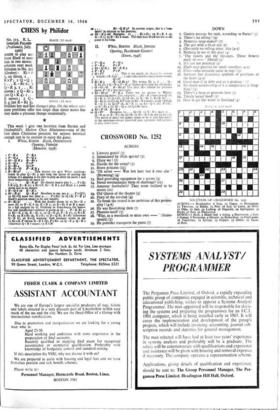CHESS by Philidor
BLACK (IO men) No. 313. R. L. SPENCER PALMER (Problemist, July. 1966) winTa to play an...; force Black to mate him in two moves solution next week. Solution to No. 312 (Gruber) : Kt - P 2, no threat. I . . KXP; 2 Q-Q 3. t.. . K - Kt 6 ; 2 Q-R 3. . . Kt moves ; 2 Q- Kt 4 (set Q - K 4). I . . B moves ; 2 Q - K 4 (set R - Kt 3)- Brilliant key and fine changed play. On the whole self- mate problems offer less scope than direct mates but they make a pleasant change occasionally.
This week I give two brevities from Barden and Heidenfeld's Modern Chess Miniatures-one of the best chess Christmas presents for anyone heretical enough just to be content to enjoy the game.
I. White, KUNIN Black, OCHSENGOIT Opening, FRENCH (MOSCOW; 1958) P - K 4 P - K3 1 P-Q 4 P-Q 4 3 Kt - Q B3 B-Kt5
4 B Q PxP
5 Q-Kt Q 4 xP
6 0- 0-0B 4 7 B- K t5? . . . P- KThis should not give White anything; better to play Q.- Kt 3 and keep the threat of moving the bishop; it's amazing to be able to play an error on move 7 and force resignation on move xi. Q - IC 4? He should simply play 7 ... P x Q; RxQB - K 2 l; 9 Kt x P, Kt - K B 3 and Black is a pawn ahead and in no danger.
8 R-q_8 ch K-B z 9 Kt - K 31 Q - R 4? Needless to say, not 9 P x Q??; so Kt xQ mate but after 9 . . . P x Kt; io Q xB, P - B 4! Black's position seems to be just tenable. ro - Kt. . With the double threat (a) II Kt - K 5 mate (b) u B -.I( 8 ch, K - B r; 12 B - Kt 6 or II 5 mate. In a full analysis by G. Fridstein in Schachmary the best- but still insufficient-defence is given as to . . P - K Kt 3; is Kt - K _5 ch, K - Kt 2; 12 Q-R 41; P-B 34 13 RXB PXB; i4 R X Kt ch, K x R; 15 B - Q 8!, B x Kt (otherwise Q - B 6); t6 B x Q winning. Still stronger seems to me 13 Kt xK P (threat B - B 6 ch), P X Kt; 14 Q - B 4, Q - B (otherwise Q- B 7 mate); 15 R x WHIM (12 mot. . • Kt - Q .83?In current jargon, this is a 'non-
move' in relation to the position.
ix Kt - K 5 els/ Resigns. . only 1.2 B-K B ch, K - B r ,• 13 B - Kt 6 mate. The only man Black has lost in the game is his king.
H. White, BARTSH Black, JENNEN Opening, BLACKMAR GAMBIT (Essen, 1948) r P - Q 4 P - Q 4 a P- K 4 PxP 3 Kt-QB3 Kt-KB3
4 P- B3 PxP
5 QxP? . . . This is too much; he should be content g with Kt x P. Still . . . it only takes him five more moves to win. 6 B- K 3 alixP -Q Kt 5? The wrong Kt 5. 6 . . . Q - K Kt SI; 7 Q- 2, P- K 4! (Euwe) gives him the advantage. 7 0 - 0 - 0 B- Ki 5? The fatal idea behind his previous move. P - B 3 was necessary. 8 Kt- Kt 51 P- K 4 There was no answer to White's devastating move. The natural 8 ... Kt - R 3 loses to 9 Q xP, §.-K 5; to QxKt, QXB ch; xi K -Kt 1, BXR (is .. . -Kt 3; 12 Qx$RPXQ; i3Kt -B2mate); I2Q-B 6 ch, -Q r; 13 Qx ch, K-K. I. 14 Kt-Q 6 ch!, PxKt; is B - Kt 5 ch, Kt - Q 2; 16 Q x Kt mate. 9 Kt xP ch K-K z to QxP! Resigns. so . . . QxQ; ii B-,B,5. mate to.. Q - R 4; ir B-B 5 ch, QxB; Ill t - R 6 ch and i3 Kt xQ. The moral of these two games seems to be to play bad moves in the opening-always provided your opponent will promise to play worse ones.






























 Previous page
Previous page